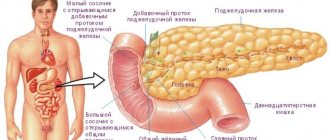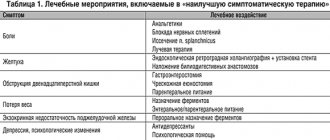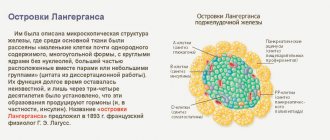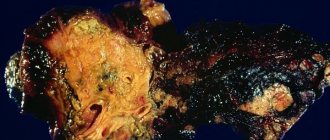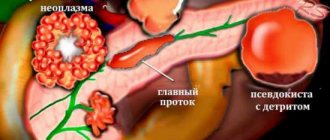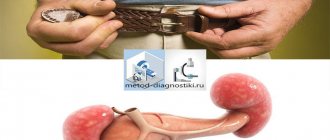Frequent patients of the oncologist are people with pancreatic cancer. The danger of this neoplasm is that it occurs for a long time without any symptoms, and when it is detected, it is already of significant size and with metastases. With such severe damage to the organ, long-term treatment with the use of very strong drugs or through surgery is necessary. In 15% of cancers detected at an early stage, patients live another 5 years.
The role of the pancreas in the body is very important. It performs exocrine and endocrine functions. The gland consists of a head, tail and body. The head of the gland connects to the bile duct, flowing into the duodenum with the gallbladder. Since the location of the gland is deep, this makes surgery to remove cancer one of the most difficult. Postoperative complications often lead to death.
Causes
The causes of pancreatic cancer are not known for certain, but there are factors that can trigger the disease. So, the risk of developing the disease increases due to:
- frequent drinking of alcohol;
- smoking for several years;
- eating spicy, fatty foods;
- diabetes mellitus;
- liver cirrhosis.

All these factors negatively affect not only the pancreas, but also the stomach, nearby lymph nodes, spleen, rectum and other organs and systems. There are also conditions that are precancerous. These include:
- Pancreatic adenoma;
- Chronic pancreatitis;
- Cyst in the pancreas.
The cause of the development of the disease in question may be a genetic predisposition to cancer. In most cases, cancer begins in people whose relatives had a tumor of any location.
Who is susceptible to the disease
Particular attention should be paid to such signs if you have a family history of pancreatic cancer or if you are in a high-risk group (smoke, are obese, abuse alcohol, etc.). An examination carried out by qualified doctors will determine the causes of the symptoms and begin treatment immediately. Also at risk are patients who have previously been diagnosed with diabetes mellitus, chronic pancreatitis, cysts, people who live in places with unfavorable environmental conditions, work in hazardous industries, or have previously undergone gastric surgery.
Choose treatment
Classification
There are not many types of pancreatic cancer.
Classification of pancreatic tumors by location:
- Head cancer;
- Body cancer;
- Tail cancer.
The most common is pancreatic cancer, and it is also the most dangerous. Pancreatic cancer occurs against the background of pancreatitis. Squamous cell carcinoma of the pancreas occurs in 90% of cases, the remaining 10% includes acinar cell carcinoma. A malignant pancreatic tumor or pancreatic cell carcinoma is very dangerous in any form.
Diet for pancreatic cancer
With this type of oncology, it is very important to monitor your own nutrition so as not to aggravate the existing condition and not provoke a relapse of the disease. In this regard, doctors recommend baking and boiling food, completely avoiding or using a minimum of salt and spices. Fried foods and various smoked foods should be prohibited. Coffee should be weak and tea should be weak. Carbonated drinks, alcohol and baked goods should be avoided.

Stages
Classification of pancreatic cancer by severity:
- In the first stage, the cancer affects only the pancreas;
- During the second stage, the cancer metastasizes to tissues and lymph nodes that are nearby;
- At the third stage, cancer penetrates into the large blood vessels of the pancreas and spreads to surrounding organs;
- The fourth degree is characterized by metastasis to distant areas of the body.
We recommend reading Retinoblastoma in children - symptoms, prognosis, treatment

Oncology detected even at the first stage, which is extremely rare, has a very poor prognosis.
Symptoms
With pancreatic cancer, symptoms appear at an advanced stage. The very first sign is pain that occurs in the epigastric region. The painful sensations do not depend on the time of eating, but become stronger at night. If the tumor is localized on the head of the gland, then painful sensations are noted in the area of the right hypochondrium and around the navel.
When the tumor affects the body and tail of the pancreas, the pain syndrome radiates to the lumbar region and between the shoulder blades. Often such symptoms change their character when changing body position, so the patient may mistake them for signs of radiculitis.
In addition to chronic pain, the patient experiences a loss of appetite, the skin becomes pale, and sleep disturbances occur. The patient feels weak, he is sick from fatty foods and meat, as well as from alcohol, caffeine and tobacco. The amount of urine excreted per day decreases, and it acquires a dark, rich color, and body weight decreases. The patient's feces become light-colored, itchy rashes appear on the skin, the gallbladder is enlarged and hurts on palpation.
Fewer enzymes begin to enter the intestines, which can cause diarrhea and steatorrhea. If the tumor compresses the duodenum, the person feels as if the stomach is full even after a light meal. There is a feeling of heaviness, belching with a rotten smell and vomiting.

The growth of metastases or the tumor itself into the wall of the stomach can be suspected by more severe signs - black vomit and the same feces, which are symptoms of internal bleeding. If the insulin-producing processes in the pancreas are destroyed, symptoms similar to diabetes mellitus occur: extreme thirst, dry mouth, itchy skin.
Symptoms of cancer
Pancreatic cancer sometimes occurs without obvious signs and symptoms, which creates conditions for its detection when it is too late to apply certain types of treatment. After all, there are certain positive methods, but their use is allowed only at the beginning of the development of oncology.
Therefore, many are interested in what signs and symptoms indicate an impending fatal problem? In total, the following first signs of cancer are identified, indicating the danger of developing this pathology of the pancreas:
- Painful symptoms in the solar plexus, in the back. It usually occurs abruptly, creates a strong pain effect, and when the legs are pressed at the knees towards the thoracic region of the person’s body, it softens and goes away.
- Dramatic weight loss. Significant weight loss for no apparent reason.
- Constant thirst. Removing it by drinking plenty of fluids will result in copious urination, which will also be a harbinger of the development of diabetes mellitus. A disease of insulin dependence, often accompanying cancer.
- Vomiting. These symptoms are characterized by compression by the tumor, a kind of transition from the stomach to the duodenum.
- Hepatitis A, B, C. With this pathology, yellowing of the eyeballs and skin occurs. Often occurs with oncology of the head of the pancreas. During this period, compression of the bile ducts occurs, which provokes developing hepatitis, accompanied by itching, due to the accumulation of bile molecules in the skin.
- Dull pain in the right hypochondrium. With the development of cancer, the tumor presses on the splenic vein, causing an enlargement of the spleen (splenomegaly).
- Loose stools (diarrhea). Fecal formations have a liquid substance and a strong odor, mostly foul. The reason for this smell is an insufficient amount of enzymes that break down the fatty component of food.
- Insulinoma. Emerging tumor with insulin production. The main symptoms of this pathology: the manifestation of trembling hands, severe weakness, fainting, hungry state, increased heart rate. It is possible to create conditions for coma. All this indicates a low level of glucose in a person’s bloodstream.
- Gastrinoma (increased production of gastrin). This type of disease is accompanied by severe heartburn, increased acidity in the stomach, and ulcers, which do not go away even with complex treatment of symptoms. Gastrin provokes additional symptoms, which leads to treatment to zero results.
- Glucagonoma. The neoplasm produces a large amount of glucagon. With this development comes sudden weight loss, increased thirst and increased urination. Red-brown formations appear on the human body, the person’s tongue becomes bright orange. All this shows an increased amount of sugar in the blood of a sick person.
Pancreatic cancer and symptoms often appear in people suffering from diabetes mellitus and pancreatitis.
structure of the pancreas
There are also the first symptoms of pancreatic cancer, thanks to which you can respond to this problem in a timely manner. The truth still depends on the location of the tumor and its aggressive manifestation. Pancreatic cancer and the first symptoms of a fatal disease that appear:
- Cancer of the head of the pancreas - the appearance of hepatitis, weight loss, pain in the abdomen, fatty discharge in the stool.
- Cancer of the tail and general body of the pancreas - weight loss, pain symptoms in the abdomen.
Diagnostics
Diagnosing pancreatic cancer is not difficult, especially considering that cancer patients turn to the doctor when the tumor has already metastasized to other organs. The most informative diagnostic method is spiral CT with double contrast. This type of diagnosis shows the tumor and individual atypical cells. In order to confirm or clarify the presence of such cells, a puncture biopsy is performed under ultrasound of the abdominal cavity.
We recommend reading Lip cancer - what the initial stage looks like, the first symptoms and signs
These diagnostic methods, along with general tests, help determine what stage the disease is at and whether the patient can be operated on. If there are significant indications for this, the patient undergoes diagnostic laparoscopy.
Treatment
Treatment for pancreatic cancer depends on the stage of the disease, where the tumor is located, what size it is, how old the patient is, and what his general health is. The goal of treatment is to completely destroy the malignant tumor. If this is not possible, doctors do everything possible to slow down the growth of the tumor and alleviate the patient’s condition.

Surgical
If the tumor is localized in the head of the pancreas, an operation is performed in which the head, duodenum, gallbladder and part of the bile duct are removed. In some cases, part of the stomach is removed. After removal, the doctor connects the part of the gland that remains with the stomach and intestines so that the patient can digest food. This operation is very traumatic and there is a high risk of infections and bleeding. The recovery period takes a long time.
For cancer of the body and tail, surgery to remove the entire tail and part of the body is indicated. If the tumor has affected the spleen, it must also be removed. According to statistics, the outcome of the operation depends on the experience of the surgeon.
Chemotherapy
Chemotherapy is used primarily for pancreatic cancer to reduce the size of the tumor. Chemicals may be in the form of tablets or intravenous solutions. Oncology is treated with one or a group of drugs that increase the effectiveness of each other.

Treatment with chemotherapy often occurs in parallel with radiation therapy, especially when the cancer process has spread to nearby organs and tissues. Chemical drug therapy may also be used in the postoperative period to prevent relapse.
Radiation therapy
Radiation therapy treatment uses X-rays or a beam of protons. Radiation therapy is often given before surgery. If surgery is contraindicated, radiation therapy is prescribed to slow the growth of the tumor.
The patient is treated using a special device, which, rotating around him, irradiates the tumor with rays coming out from different points. Sometimes radiation is given directly during surgery.
Targeted therapy
This is a new method of treating cancer, used when chemotherapy is ineffective. The drugs that the patient takes act directly on cancer cells, but do not affect healthy tissue, and also boost the immune system, unlike chemotherapy. Also, targeted medications prevent the tumor from feeding by blocking its blood vessels.
Folk remedies
Cancerous tumors, including pancreatic oncology, cannot be cured using traditional medicine, but it can improve the patient’s condition, especially after radiation or chemotherapy.
We recommend reading Features of the course of papillary thyroid cancer

Traditional medicine should under no circumstances replace treatment with medications or surgery. Before using any folk remedy for pancreatic cancer, you must consult a doctor, otherwise you can only worsen the situation.
Pancreatic cancer treatment
The choice of a specific method of treating cancer and the duration of therapy depend on the stage of the disease. The surgeon determines how large the size of the tumor is, whether it has had time to grow, how deep and what structures it has damaged. Only after this the treatment method is selected. Of course, the best option is to remove the tumor and nearby lymph nodes, followed by irradiation of the area. However, this option can only be used at stage I of cancer development. If a patient is diagnosed with stage II, III or IV cancer, he needs other methods of therapy.
Surgical techniques:
- Removal of the pancreas. The affected organ is removed in full, but only if the tumor has not yet left the gland.
- Operation using the Whipple technique. Suitable for fighting cancer in the first stage of the disease, when the disease is detected in the head of the organ. In this case, the head of the pancreas is removed along with the tumor, and at the same time part of the duodenum, lymph nodes and part of the stomach located in the immediate vicinity are excised.
Palliative treatments, i.e. methods that do not allow surgical intervention are used at stage IV of the disease, when the tumor has already metastasized to neighboring organs, and there is no point in removing it. In this case, doctors take measures to make the patient’s life easier.
Chemotherapy
After the operation, as a rule, a course of chemotherapy drugs is administered. In this case, the patient is prescribed antitumor drugs that stop the growth of malignant cells. Depending on the size and spread of the tumor, monotherapy (one drug) or multicomponent treatment (several drugs) may be used.
Radiation therapy
This treatment method can be used at different stages of the fight against cancer. For example, radiation administered before surgery reduces the size of the tumor, and after surgery it prevents relapses.
Complications and consequences
Complications often occur as the cancer begins to progress. During this period, you may experience:
- Jaundice due to obstruction of the bile ducts. With this complication, the skin, mucous membranes and sclera become yellow, the urine darkens, and the feces lighten and become clay-like.
- Painful sensations due to pressure from the tumor on the nerve endings.
- Intestinal obstruction due to blockage of the lumen by a tumor.
- Loss of body weight due to frequent vomiting and poor appetite, as well as due to impaired digestion and absorption of food.
- Heartburn with cancer is also not uncommon, as is vomiting with nausea.
Complications can very rarely be avoided, since cancer is diagnosed at a late stage of development.
Forecast
Due to the rapid growth and metastasis of the tumor, the prognosis for pancreatic cancer is more than disappointing. Life expectancy with such a diagnosis depends on the type of cancer, stage, initial state of health, and treatment measures. With active treatment, the maximum lifespan of the patient is about five years.
- without surgical intervention when the last stage is diagnosed, a person lives no more than six months;
- a course of chemotherapy prolongs life expectancy from six months to nine months;
- radiation therapy without surgery gives the patient another year to live;
- after radical surgery, life expectancy can vary from one and a half to two years (in rare cases, up to five);
- surgery along with radiation therapy gives one and a half years;
- when diagnosed with stage 4, only four percent of people live more than a year and two percent live another five years.
Naturally, a painful existence with pancreatic cancer can hardly be called life.
